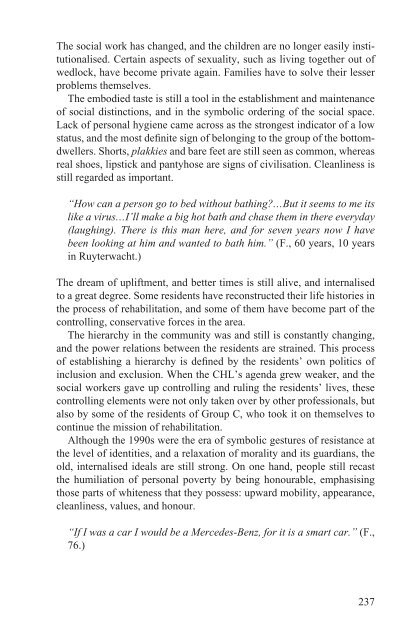The Making of a Good White - E-thesis - Helsinki.fi
The Making of a Good White - E-thesis - Helsinki.fi
The Making of a Good White - E-thesis - Helsinki.fi
You also want an ePaper? Increase the reach of your titles
YUMPU automatically turns print PDFs into web optimized ePapers that Google loves.
<strong>The</strong> social work has changed, and the children are no longer easily institutionalised.<br />
Certain aspects <strong>of</strong> sexuality, such as living together out <strong>of</strong><br />
wedlock, have become private again. Families have to solve their lesser<br />
problems themselves.<br />
<strong>The</strong> embodied taste is still a tool in the establishment and maintenance<br />
<strong>of</strong> social distinctions, and in the symbolic ordering <strong>of</strong> the social space.<br />
Lack <strong>of</strong> personal hygiene came across as the strongest indicator <strong>of</strong> a low<br />
status, and the most de<strong>fi</strong>nite sign <strong>of</strong> belonging to the group <strong>of</strong> the bottomdwellers.<br />
Shorts, plakkies and bare feet are still seen as common, whereas<br />
real shoes, lipstick and pantyhose are signs <strong>of</strong> civilisation. Cleanliness is<br />
still regarded as important.<br />
“How can a person go to bed without bathing?…But it seems to me its<br />
like a virus…I’ll make a big hot bath and chase them in there everyday<br />
(laughing). <strong>The</strong>re is this man here, and for seven years now I have<br />
been looking at him and wanted to bath him.” (F., 60 years, 10 years<br />
in Ruyterwacht.)<br />
<strong>The</strong> dream <strong>of</strong> upliftment, and better times is still alive, and internalised<br />
to a great degree. Some residents have reconstructed their life histories in<br />
the process <strong>of</strong> rehabilitation, and some <strong>of</strong> them have become part <strong>of</strong> the<br />
controlling, conservative forces in the area.<br />
<strong>The</strong> hierarchy in the community was and still is constantly changing,<br />
and the power relations between the residents are strained. This process<br />
<strong>of</strong> establishing a hierarchy is de<strong>fi</strong>ned by the residents’ own politics <strong>of</strong><br />
inclusion and exclusion. When the CHL’s agenda grew weaker, and the<br />
social workers gave up controlling and ruling the residents’ lives, these<br />
controlling elements were not only taken over by other pr<strong>of</strong>essionals, but<br />
also by some <strong>of</strong> the residents <strong>of</strong> Group C, who took it on themselves to<br />
continue the mission <strong>of</strong> rehabilitation.<br />
Although the 1990s were the era <strong>of</strong> symbolic gestures <strong>of</strong> resistance at<br />
the level <strong>of</strong> identities, and a relaxation <strong>of</strong> morality and its guardians, the<br />
old, internalised ideals are still strong. On one hand, people still recast<br />
the humiliation <strong>of</strong> personal poverty by being honourable, emphasising<br />
those parts <strong>of</strong> whiteness that they possess: upward mobility, appearance,<br />
cleanliness, values, and honour.<br />
“If I was a car I would be a Mercedes-Benz, for it is a smart car.” (F.,<br />
76.)<br />
237
















